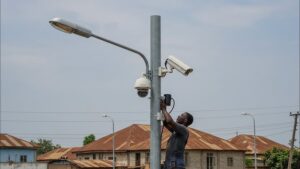
The Nigerian Meteorological Agency (NiMet) recently released its 2023 seasonal climate predictions with a forecast of an early onset of rain across the country. In this piece TOPE SUNDAY wonders how prepared Nigerians are.
Like the rest of the world, Nigerians are expecting rain for the year 2023. Though some towns and villages had had their first rains of the year, others are yet to witness a drizzle.
Rain comes with sweet memories, and aside from cooling off the harsh weather, it is also a source of water for those who are experiencing water scarcity. However, it comes with mixed feelings! Its season comes with flooding, which could be massive at times.

The 2023 predictions
The Nigerian Meteorological Agency (NiMet) in its recently released seasonal prediction, said the rainfall onset date would likely be from March 2 in southern states while other parts could delay till around July 7.
NiMet’s director-general, Prof. Mansur Matazu, who presented the report in Abuja, said the annual rainfall amount was expected to range from 420 mm in the northern region to 3,253 mm in the coastal areas.
“The prediction shows that the earliest rains will likely occur on or around the 2nd of March 2023 in the coastal zones of south-south states of Bayelsa, Akwa-Ibom, and Rivers. The onset date is expected to increase latitudinally with the ITD northward oscillation as the year progresses. The inland cities of the south are therefore likely to have onset in April while areas around the central states are likely to have onset in May.
“The extreme northern states are predicted to have onset between June and July, with the Northern fringes of Sokoto, Kebbi, Zamfara, Kano, Katsina, Jigawa, Yobe, and Borno states predicted to likely have onset between 20th June and 7th July of 2023,” he had said.
He also said the length of the growing season will range from 84 to 283 days, adding that most parts of the country would experience the long-term average, while some parts such as Katsina, Jigawa, and Kano, would have shorter-term average length.
An early end of the season is predicted over parts of the south, especially in Osun, Ondo, Edo, Delta, Imo, Bayelsa, Rivers, Akwa Ibom, and eastern parts of Ogun and Lagos and parts of Yobe, Adamawa, Niger, Nasarawa and Kogi. However, an extended rainfall season is predicted over parts of Gombe, Kaduna, Kwara, Enugu, Anambra, western Ogun, and Lagos. The end-of-season period is expected to range from September 26 till December 25.
“When compared to last year, the little dry season (August Break) for 2023 is expected to be less intense. It is expected to last between 14 and 20 days starting from late July, especially over the southwest of the country.
“Other forecasts such as the temperature for the first five months of the year, malaria and meningitis forecast along with the socio-economic implications of these forecasts are contained in explicit details in the documents.”
2022 rainy season in retrospect
The 2022 rainy season started very well but ended with severe flooding disasters that claimed lives and rendered some Nigerians homeless.
One of the passengers, Eunice Moses, who was affected by the Lokoja flood, said she spent three days on the road, adding that she was ferried over Murtala Muhammed Bridge before she could cross over to the Abuja route.
“My experience last year during the rainy season was not pleasant. I spent three days on the road. This development made us resort to Ferry, which crossed us over to the other side,” she said.
While Miss Eunice was lucky, because she was a traveler, some residents of the town and other victims in states like Jigawa and Bayelsa were not. Some of them were reportedly dead, while others lost their property to the incident.
According to a report, the 2022 flooding in Nigeria was one of the country’s most severe flooding disasters since 2012. A statement released on October 24 by the Ministry of Humanitarian Affairs and Disasters Management said over 3.2 million Nigerians were affected out of which 600 lost their lives.
The statement added the flood disaster destroyed hundreds of farmlands, while thousands of houses were submerged in different states across the country.
Earlier, the United Nations International Children’s Emergency Fund (UNICEF) had disclosed that 34 states were flooded during the period.
“The floods, which have affected 34 out of the 36 states in the country, have displaced 1.3 million people. Over 600 people have lost their lives, and over 200,000 houses have either been partially or fully damaged,” the body said.
Reactions
Reacting to the 2023 prediction, the director-general of the National Emergency Management Agency (NEMA), Mustapha Ahmed, said NiMet’s seasonal climate prediction helps NEMA conduct an analysis of disaster risk implications and produce disaster early warning messages for the protection of lives and assets.
He said the unprecedented flood disaster in 2022 was an eye-opener, noting that the agency intends to plan and intensify inter-agency collaboration to forestall any negative impacts.
“I look forward to bringing together experts from NIMET and other relevant agencies under one roof to analyse the disaster risk implication of the SCP and develop necessary advisories including risk mapping to guide all NEMA partners to mitigate disaster losses across the nation.
“I make bold to say that the negative impacts of the annually recurring flood disaster in Nigeria could have been more devastating without the early warning information developed out of the NIMET SCP and downscaled to the various end-user-age,” he said.
Also, the permanent secretary, the Federal Ministry of Aviation, Dr. Emmanuel Meribole, said: “The relevance and the critical importance of the products and services emanating from NiMet cannot be overemphasized. Over the years, nation-building and sustainable developments are closely linked to the vagaries of weather and climate, including how well nations take the advantage of the weather and climate information available to them.
“The level of response by people and critical actors in the weather and climate value-chain is key to maximising the benefit of Early Warnings to reduce risks and impacts of weather-related disasters.”
He noted that the SCP has also helped increase and improve the level of preparedness by federal and state emergency management agencies, complement the flood prediction by Nigeria Hydrological Services Agency (NIHSA), and served as an advisory tool for many stakeholders at the federal, state and local government levels.
However, on his part, the executive director, the Institute for Agricultural Research (IAR), Ahmadu Bello Bello University (ABU), Zaria, Prof. Mohammed Faguji, recommended the late parts of May and early June as the best period for cereals planting for moist savannah parts of Nigeria.
According to him, the moist savannah part of the country lies along the southern part of Katsina, Zamfara, and Kaduna States, and goes towards the Federal Capital Territory.
Faguji said planting of legumes such as groundnut and soya beans should follow almost immediately after planting the cereals; stressing that cowpea planting should start around July 22. He, however, added that cowpea should be planted in the early parts of July in places like Kano, Jigawa, and the northern part of Bauchi states.
Faguji described the NIMET’s prediction on the normal secession of the rainfall as good news because the rainy season would cease at the time we are used to.
“For example, in the southern guinea savanna, such as the southern part of Kaduna state, rainfall ceases between Oct. 5 and 10; while in the drier part of the country, the rain ceases around Sept. 30
“The above picture will persist during this year’s wet season farming except for Jigawa, Kano, and Katsina States where it was predicted that the rain will cease earlier than normal,” he said.
The executive director advised the state offices of Agricultural Development Projects (ADPs) on the need to sensitise farmers on planting early-maturing seed varieties. He further advised the farmers to start looking for these varieties that are early maturing to feat for the early cessation of rainfall.
Faguji said the prediction from NIMET also indicated that there would be sporadic dry spells that do not follow any pattern except for Jigawa, Kano, and Katsina states where the rain will completely cease.






